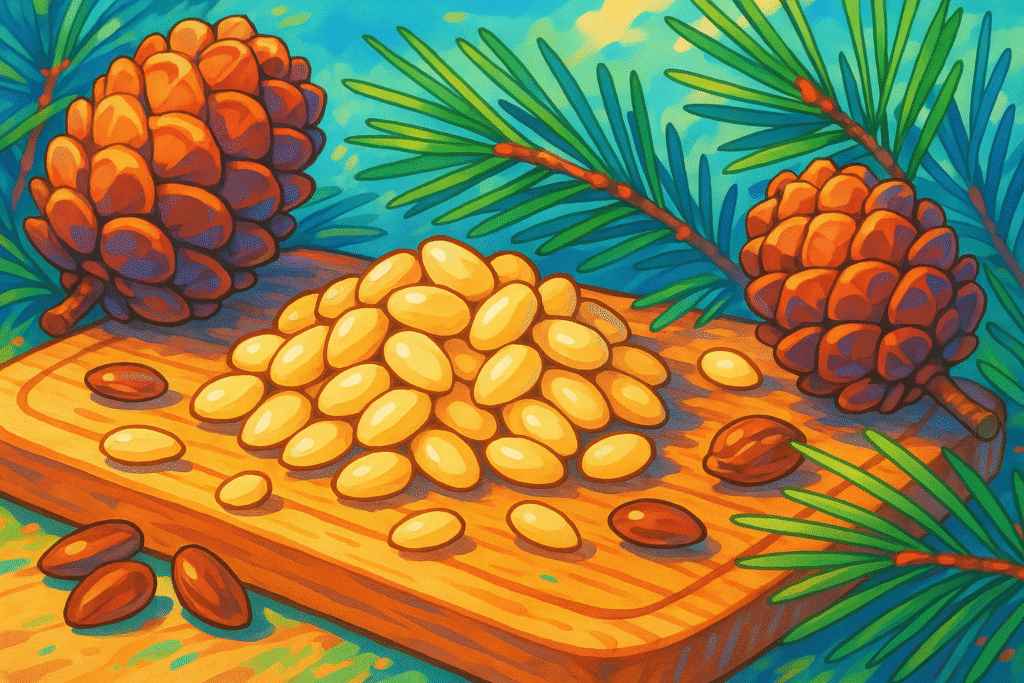Pine nut (Pinus spp.)

About Pine nut
Pine nuts are the ivory-hued seeds of pine trees, notably species within the Pinus genus. Small, tear-shaped, and exquisitely tender, pine nuts deliver a distinctively buttery, sweet flavor with a subtle resinous undertone. Their rich oil content makes them uniquely creamy, whether tossed in salads, baked in breads, or blended into sauces like Italian pesto or the Levantine muhammara. Carefully harvested from the cones of slow-growing pines, these nuts are cherished across Eurasia and North Africa for their texture and luxurious taste.
The History of Pine nut
Humans have prized pine nuts for thousands of years, first foraged by Paleolithic communities across Eurasia. Ancient Greeks, Romans, and peoples of Central Asia valued pine nuts for both sustenance and ceremonial feasting. In the Mediterranean, pine nuts have been added to pilafs, cakes, and sauces since antiquity—featured in Italian, Greek, and Turkish kitchens. In China and Korea, local species underpin confections and nourishing porridges. Desert dwellers from North Africa to Central Asia gathered wild pine nuts for their calorie-dense nutrition and long shelf-life, making them a valuable food in nomadic cultures.
The Science of Pine nut
Pine nuts are loaded with heart-healthy monounsaturated fats, vitamin E, protein, and essential minerals such as magnesium, zinc, and iron. Their delicate, buttery taste is due to a high content of pinolenic acid, a rare fatty acid studied for its roles in appetite suppression and anti-inflammatory processes. These nuts also contain antioxidants and a range of B vitamins. One scientific curiosity is “pine mouth”—a harmless, temporary bitter aftertaste experienced by some people after eating certain pine species, though the cause is not fully understood.
The Geography of Pine nut
Pine nuts are harvested from multiple pine species across distinct regions: Mediterranean pinus pinea is famous for its long, elegant seeds; Korean and Siberian pines for smaller, meatier kernels; and Himalayan blue pine for intensely flavored, petite nuts. Each variety’s flavor, texture, and oil content are shaped by climate and altitude. Pine nut harvests are labor-intensive, requiring the collection and cracking of hardy cones, so quality and price vary greatly by region. The biggest supplies come from Mediterranean countries (Italy, Spain, Turkey), China, Russia, Afghanistan, and Korea.
Varieties of Pine nut
Mediterranean Stone Pine (Pinus pinea)
Prized in Italy, Spain, and parts of North Africa, these long, slender seeds are pale, buttery, and sweet. The classic nut for traditional pesto and Mediterranean pastries.
Korean Pine (Pinus koraiensis)
Shorter, fatter nuts with a deep, earthy flavor and high oil content. Essential in Korean cuisine—added to rice cakes, porridges, and desserts.
Siberian Pine (Pinus sibirica)
Well adapted to cold climates, these slightly resinous, robust-flavored pine nuts are smaller and chewier. Used across Russia and Mongolia in salads and porridges.
Chilgoza Pine (Pinus gerardiana)
Native to the Himalayas, especially in Afghanistan, Pakistan, and northern India. These nuts are slender, rich, and aromatic—popular in South Asian confections and savory pilafs.
FAQs All your questions about Pine nut: answered
Why are pine nuts so expensive?
Pine nuts require years of tree growth, careful cone harvesting, and laborious shelling—many processes still done by hand. Yields are small and variable, leading to high prices.
What causes “pine mouth” or bitterness after eating pine nuts?
Some species, particularly those from certain Chinese pines, can cause a temporary bitter or metallic aftertaste known as “pine mouth.” While harmless, not everyone experiences this effect.
Can pine nuts be eaten raw, or should they always be roasted?
Pine nuts are delicious raw—soft and sweet—but roasting or toasting enhances their aroma and adds a golden crunch. Watch closely, as their high oil content means they burn easily.
Are pine nuts safe for people with nut allergies?
Pine nuts are botanically seeds, not true nuts, but they can cause reactions in individuals sensitive to tree nuts. Anyone with nut allergies should consult a doctor before consuming them.
How are pine nuts used around the world?
They are blended into Italian pesto, tossed in Levantine salads (like fattoush), baked in Turkish desserts, sprinkled atop Chinese stir-fries, and simmered in Central Asian plovs and porridges. Their delicate creaminess lends richness to both sweet and savory recipes.